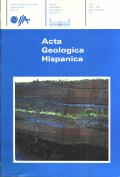Estimacions hidrològiques i de moviment de sediment a la riuada del 7 d'Agost de 1996 a la conca del Barranco de Arás (Pirineu aragonès)
Abstract
During 7 August 1996 a summer thunderstorm with rainfall intensity up to 500 mm h-1 occurred over the 18 km2 Arás drainage basin, a mountainons torrent tributary of the Gállego river in central Pyrenees. The resultant flood peak was of the order of 500 m3 S-1, a thousandyear ietum penod discharge for the area. As a consequence, the campground located on the alluvial fan at the torrent outlet was flooded with seven-hundred people inside, causing eighty-six people death and many injured, damage on properties and great social impact.
Two physical factors can be identified as main responsible for this high magnitude and low frequency event: i) the low permeability of the soil due to high moisture content caused by an unusual rainy season, which resulted in large excess of quick surface runoff and ii) in-channel high steep slopes up to 20%, which causetl flood waves at estimated velocities of 7 m S-l. The most active storm-cell was located in the headwaters Betés subbasin, which represents 20% of the catchment area but contributed 60% of the peak discharge. Specific maximum discharge in the Betés basin reached 85 m3 S-1 km-2. Mobilisation of sediment from stream bed and footslopes was also extremely high.
The competence of the torrent was enough to entrain rocks up to 10 m size in some reaches, under shear stress of 10000 Pa. A minimum of 100,000 tm of coarse and fine sediment was exported out of the Arás basin, part of it stored in a series of check-dams located in the lower reaches of the torrent, part eroded from bed and banks in the drainage net. Estimated bedload transport rate at the peak discharge has been estimated around 300 kg m-1 S-1, tliree orders off magnitude higher than those recorded in mountainous torrents in the Catalan Coastal Ranges during floods.


